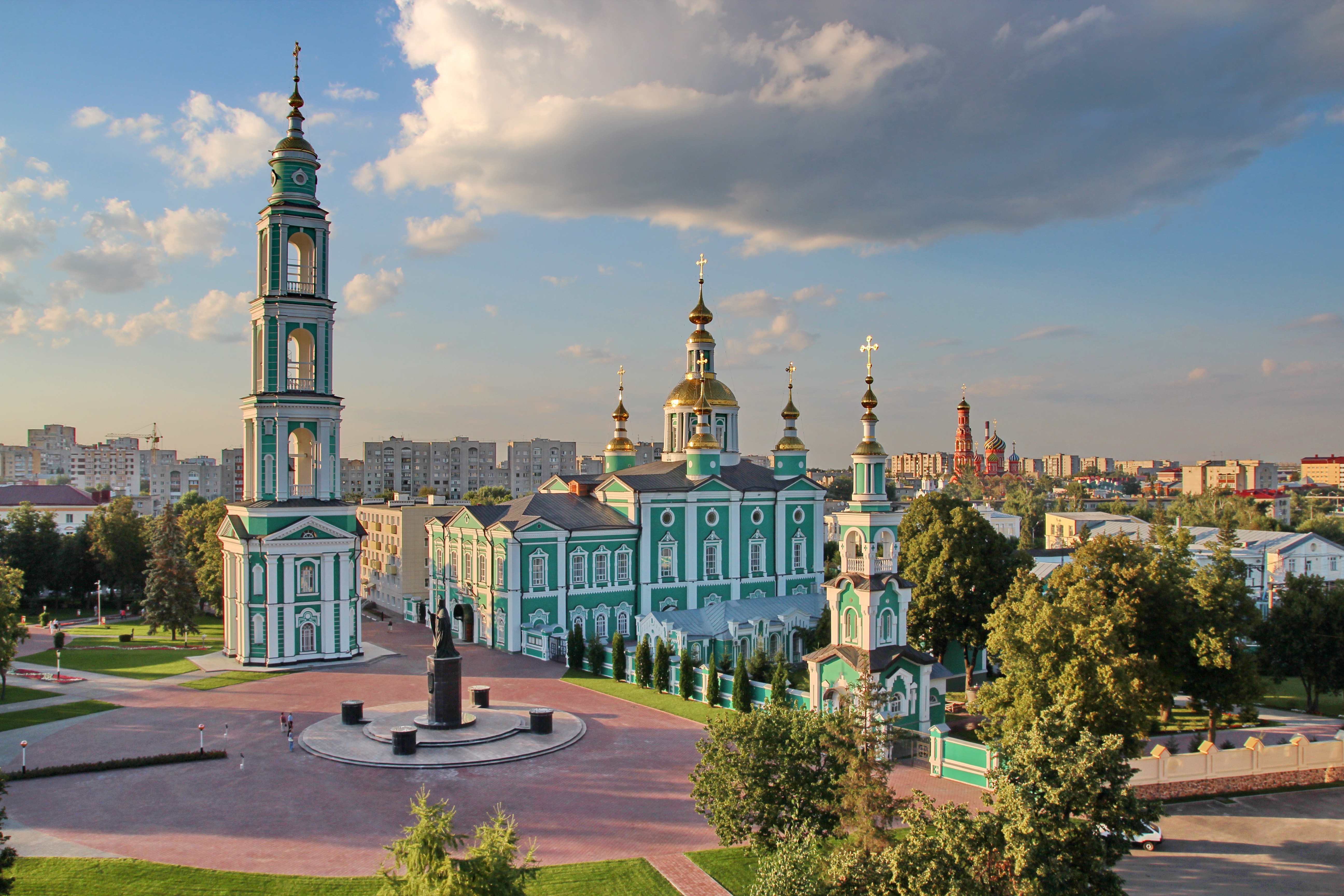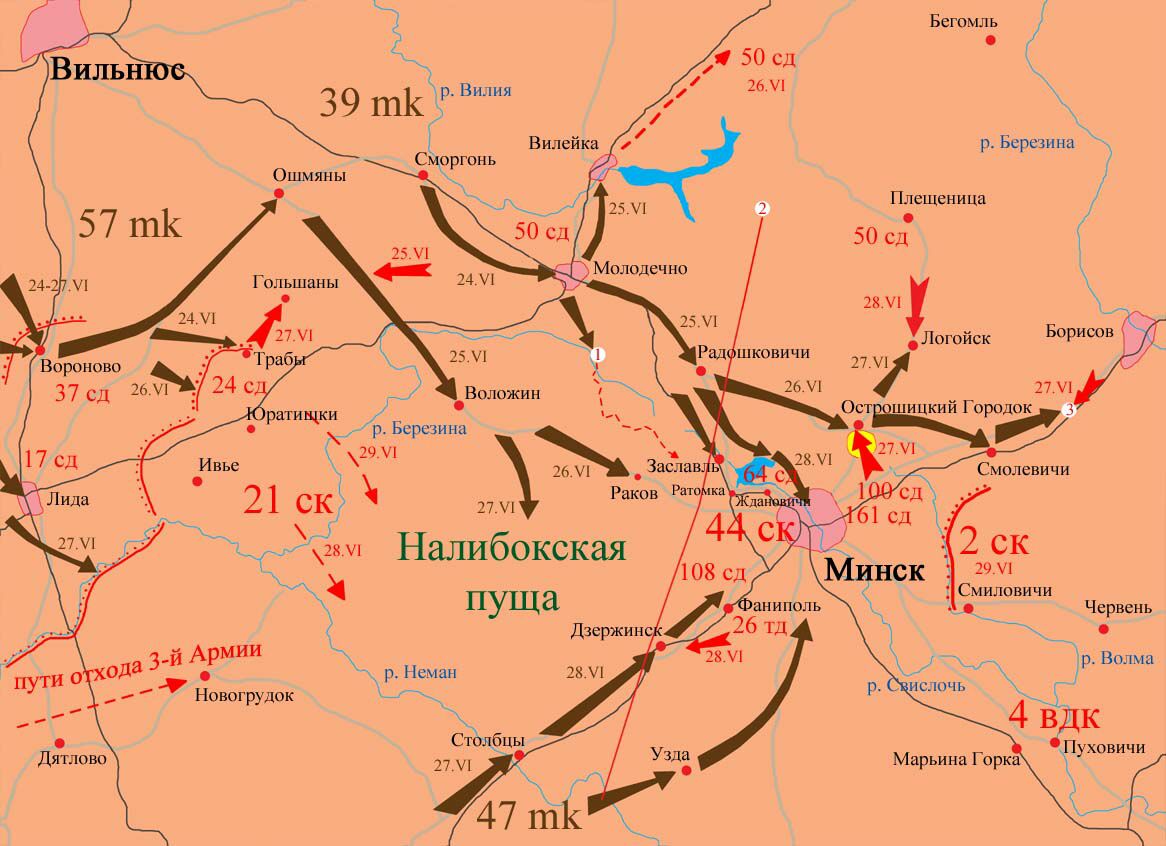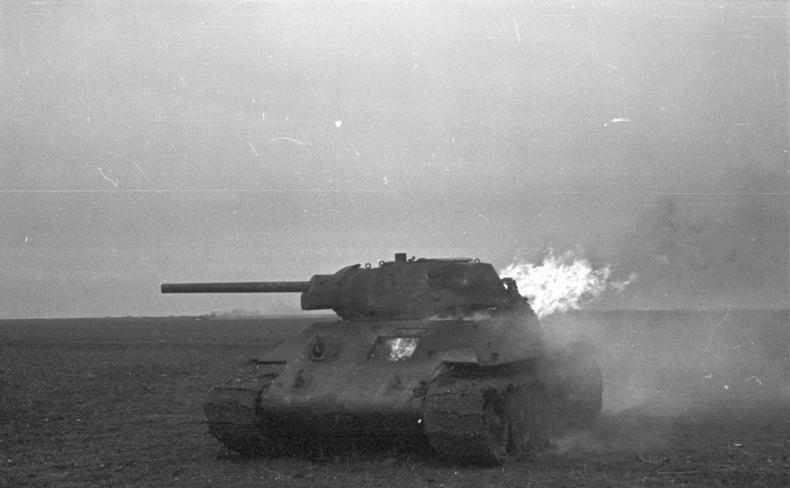|
Mikhail Panov
Mikhail Feodorovich Panov ( Russian: ''Михаил Фёдорович Панов''; 21 November 1901, in Ovchinikov, Vitebsk Governorate, Russian Empire – 8 May 1979, in Moscow, Soviet Union) was a Soviet general. Biography Early life Born to a peasant family, Panov worked in a St. Peterburg factory from a young age. In 1919, he joined both the Communist Party and the Red Army, participating in the Civil War. In 1924 he attended a tank commanders school and, in 1928, underwent advanced infantry officers training. He graduated from the Stalin Academy for Motorization and Mechanization in 1938, assuming command over the 48th Light Tank Brigade in November of that year. In March 1941, he was appointed commander of the 33rd Tank Division. World War II On the eve of the German invasion, the division was still organizing in Sokółka. It was part of the 3rd Army's 11th Mechanized Corps. When the Germans attacked, Panov launched a hasty counter-offensive. Eventually, with man ... [...More Info...] [...Related Items...] OR: [Wikipedia] [Google] [Baidu] |
Nevelsky District, Pskov Oblast
Nevelsky District (russian: Не́вельский райо́н) is an administrativeLaw #833-oz and municipalLaw #420-oz district (raion), one of the twenty-four in Pskov Oblast, Russia. It is located in the south of the oblast and borders with Novosokolnichesky District in the north, Velikoluksky District in the east, Usvyatsky District in the southeast, Haradok, Polotsk, and Rasony Districts of Vitebsk Region of Belarus in the south (forming part of the Belarus–Russia border), Sebezhsky District in the west, and with Pustoshkinsky District in the northwest. The area of the district is . Its administrative center is the town of Nevel. Population: 31,419 ( 2002 Census); The population of Nevel accounts for 61.2% of the district's total population. Geography The territory of the district is split between the basins of the Lovat and Daugava Rivers. The upper course of the Lovat flows close to the boundaries of the district and the rivers in the eastern part of the district ... [...More Info...] [...Related Items...] OR: [Wikipedia] [Google] [Baidu] |
Civil War In Russia
{{Infobox military conflict , conflict = Russian Civil War , partof = the Russian Revolution and the aftermath of World War I , image = , caption = Clockwise from top left: {{flatlist, *Soldiers of the Don Army *Soldiers of the Siberian Army *Suppression of the Kronstadt rebellion *American troop in Vladivostok during the intervention *Victims of the Red Terror in Crimea *Hanging of workers in Yekaterinoslav by the Austrians *A review of Red Army troops in Moscow. , date = 7 November 1917 – 16 June 1923{{Efn, The main phase ended on 25 October 1922. Revolt against the Bolsheviks continued in Central Asia and the Far East through the 1920s and 1930s.{{cite book, last=Mawdsley, first=Evan, title=The Russian Civil War, location=New York, publisher=Pegasus Books, year=2007, isbn=9781681770093, url=https://archive.org/details/russiancivilwar00evan, url-access=registration{{rp, 3,230(5 years, 7 months and 9 day ... [...More Info...] [...Related Items...] OR: [Wikipedia] [Google] [Baidu] |
Operation Winter Storm
Operation Winter Storm (german: Unternehmen Wintergewitter), a German offensive in December 1942 during World War II, involved the German 4th Panzer Army failing to break the Soviet encirclement of the German 6th Army during the Battle of Stalingrad. In late November 1942 the Red Army had completed Operation Uranus, encircling some 300,000 Axis personnel in and around the city of Stalingrad. German forces within the Stalingrad pocket and directly outside were reorganized (22 November 1942) into Army Group Don and placed under the command of Field Marshal Erich von Manstein. The Red Army continued to allocate as many resources as possible to the planned Operation Saturn to isolate Army Group A from the rest of the German Army. To remedy the situation, the ''Luftwaffe'' attempted to supply German forces in Stalingrad through an air bridge. When the ''Luftwaffe'' failed and it became obvious that a breakout could succeed only if launched as early as possible, Manstein decided on ... [...More Info...] [...Related Items...] OR: [Wikipedia] [Google] [Baidu] |
Erich Von Manstein
Fritz Erich Georg Eduard von Manstein (born Fritz Erich Georg Eduard von Lewinski; 24 November 1887 – 9 June 1973) was a German Field Marshal of the ''Wehrmacht'' during the Second World War, who was subsequently convicted of war crimes and sentenced to 18 years imprisonment. Born into an aristocratic Prussian family with a long history of military service, Manstein joined the army at a young age and saw service on both the Western and Eastern Front during the First World War (1914–18). He rose to the rank of captain by the end of the war and was active in the inter-war period helping Germany rebuild its armed forces. In September 1939, during the invasion of Poland at the beginning of the Second World War, he was serving as Chief of Staff to Gerd von Rundstedt's Army Group South. Adolf Hitler chose Manstein's strategy for the invasion of France of May 1940, a plan later refined by Franz Halder and other members of the OKH. Anticipating a firm Allied reaction should th ... [...More Info...] [...Related Items...] OR: [Wikipedia] [Google] [Baidu] |
Battle Of Stalingrad
The Battle of Stalingrad (23 August 19422 February 1943) was a major battle on the Eastern Front of World War II where Nazi Germany and its allies unsuccessfully fought the Soviet Union for control of the city of Stalingrad (later renamed to Volgograd) in Southern Russia. The battle was marked by fierce close-quarters combat and direct assaults on civilians in air raids, with the battle epitomizing urban warfare. The Battle of Stalingrad was the deadliest battle to take place during the Second World War and is one of the bloodiest battles in the history of warfare, with an estimated 2 million total casualties. Today, the Battle of Stalingrad is universally regarded as the turning point in the European Theatre of war, as it forced the '' Oberkommando der Wehrmacht'' (German High Command) to withdraw considerable military forces from other areas in occupied Europe to replace German losses on the Eastern Front, ending with the rout of the six field armies of Army G ... [...More Info...] [...Related Items...] OR: [Wikipedia] [Google] [Baidu] |
2nd Guards Army
The 2nd Guards Army was a field army of the Soviet Union's Red Army that fought in World War II, most notably at Stalingrad. History The 2nd Guards Army was formed according to the order of the Staff of the Supreme High Command (Stavka) from October 23, 1942, on the basis of the 1st Reserve Army. Formation and training took place in Tambov, Michurinsk and Morshansk areas. On 1 November 1942 the Combat composition of the Soviet Army lists 1st Reserve Army with the 1st Guards Rifle Corps – 24th Guards, 33rd Guards and 98th rifle divisions nder Guards General-Major I. I. Missan and the 13th Guards Rifle Corps with the 49th Guards, 3rd Guards and 387th divisions. By the time of the Battle of Stalingrad, the 2nd Guards Army had become one of the most powerful units in the Red Army. The 2nd Guards Army appeared on the scene after the Soviet Operation Uranus had successfully encircled the German Sixth Army at Stalingrad in November 1942. In December 1942, as preparations s ... [...More Info...] [...Related Items...] OR: [Wikipedia] [Google] [Baidu] |
Tambov
Tambov (, ; rus, Тамбов, p=tɐmˈbof) is a types of inhabited localities in Russia, city and the administrative center of Tambov Oblast, Central Federal District, central Russia, at the confluence of the Tsna River (Moksha basin), Tsna and Studenets Rivers, about south-southeast of Moscow. Population: 280,161 (Russian Census (2010), 2010 Census); 293,658 (Russian Census (2002), 2002 Census); Etymology The name "Tambov" originates from the Moksha language, Mokshan word( mdf, томбале, tombale, the other side, the remote one) Geography Urban layout In terms of its layout, Tambov was no different from other fortified cities - the Kremlin, the prison and a small settlement. The chosen place was in full compliance with the requirements of the fortification. From the north and east, the new fortress was washed by rivers, and from the west and south it was protected by artificial ditches filled with water by the Studenets River. The Kremlin was surrounded by a six-meter w ... [...More Info...] [...Related Items...] OR: [Wikipedia] [Google] [Baidu] |
Battle Of Białystok–Minsk
The Battle of Białystok–Minsk was a German strategic operation conducted by the Wehrmacht's Army Group Centre under Field Marshal Fedor von Bock during the penetration of the Soviet border region in the opening stage of Operation Barbarossa, lasting from 22 June to 9 July 1941. The Army Group's 2nd Panzer Group under Colonel General Heinz Guderian and the 3rd Panzer Group under Colonel General Hermann Hoth decimated the Soviet frontier defenses, defeated all Soviet counter-attacks and encircled four Soviet Armies of the Red Army's Western Front near Białystok and Minsk by 30 June. The majority of the Western Front was enclosed within, and the pockets were liquidated by 9 July. The Red Army lost 420,000 men against Wehrmacht casualties of over 12,157. The Germans destroyed the Soviet Western Front in 18 days and advanced 460 kilometers into the Soviet Union, causing many to believe that the Germans had effectively won the war against the Soviet Union. Prelude Commanded ... [...More Info...] [...Related Items...] OR: [Wikipedia] [Google] [Baidu] |
11th Mechanized Corps (Soviet Union)
The 11th Mechanized Corps was a mechanized corps of the Red Army, formed twice. The corps was first formed as one of the original two Red Army mechanized corps from the 11th Rifle Division in Leningrad. In 1934 it was transferred to the Transbaikal Military District and in 1938 became the 20th Tank Corps. The corps was reformed in March 1941 in western Belarus. After the German invasion of the Soviet Union, the understrength corps was destroyed in the Battle of Białystok–Minsk. History First Formation The 11th Mechanized Corps was formed from March to September 1932 from the 11th Rifle Division in Leningrad, one of the first two Red Army mechanized corps. The corps was commanded by division commander Komkor Kasyan Chaykovsky and its chief of staff was Mikhail Bakshi. The 31st Mechanized Brigade was formed from the 32nd Rifle Regiment named for Volodarsky, the 32nd Mechanized Brigade from the 33rd Rifle Regiment named for Voskov, the 33rd Rifle and Machine Gun Brigad ... [...More Info...] [...Related Items...] OR: [Wikipedia] [Google] [Baidu] |
3rd Army (Soviet Union)
The 3rd Army () was a field army of the Red Army during World War II. Polish Campaign The 3rd Army was formed on 15 September 1939 from the Vitebsk Group of Forces, part of the Belorussian Front, which had been formed four days earlier from the Belorussian Special Military District for the Soviet invasion of Poland. The army was commanded by ''Komkor'' Vasily Kuznetsov. It included the 4th Rifle Corps with the 50th and 27th Rifle Divisions, in addition to the 5th Rifle Division, the 24th Cavalry Division, and the 22nd and 25th Tank Brigades. The units numbered 121,968 men and fielded 752 guns and 743 tanks on 17 September. The 3rd Army saw its first action in September 1939, taking part in the operation in Belarus and Poland. The invasion was conducted under the terms of the Molotov–Ribbentrop Pact, which divided Poland between the Soviet Union and Nazi Germany and guaranteed that neither country would attack the other. Order of Battle on 2 October 1939: * 10th Rifle Cor ... [...More Info...] [...Related Items...] OR: [Wikipedia] [Google] [Baidu] |
Sokółka
Sokółka (; lt, Sokulka, Sakalinė, be, Саку́лка, yi, סאקאלקע, Sokolke) is a town in northeastern Poland, seat of the Sokółka County in Podlaskie Voivodeship. It is a busy rail junction located on the international Warsaw–Białystok–Grodno line, with additional connections which go to Suwałki and the Lithuanian border. History The settlement was founded as a royal village located on the route connecting Knyszyn and Grodno. Sokółka was granted town rights by King Sigismund III Vasa in 1609. The town's layout with its central square is attributed to starost Antoni Tyzenhauz. In the Third Partition of Poland, in 1795, the town was annexed by Prussia, and in 1807 it passed to the Russian Partition of Poland. In 1861, Walery Wróblewski came to Sokółka and founded a secret organization in preparation for a Polish uprising, which broke out in 1863. He was one of the main organizers of the January Uprising in the territory between Białystok and Grodno. ... [...More Info...] [...Related Items...] OR: [Wikipedia] [Google] [Baidu] |
Operation Barbarossa
Operation Barbarossa (german: link=no, Unternehmen Barbarossa; ) was the invasion of the Soviet Union by Nazi Germany and many of its Axis allies, starting on Sunday, 22 June 1941, during the Second World War. The operation, code-named after Frederick Barbarossa ("red beard"), a 12th-century Holy Roman emperor and German king, put into action Nazi Germany's ideological goal of conquering the western Soviet Union to repopulate it with Germans. The German aimed to use some of the conquered people as forced labour for the Axis war effort while acquiring the oil reserves of the Caucasus as well as the agricultural resources of various Soviet territories. Their ultimate goal was to create more (living space) for Germany, and the eventual extermination of the indigenous Slavic peoples by mass deportation to Siberia, Germanisation, enslavement, and genocide. In the two years leading up to the invasion, Nazi Germany and the Soviet Union signed political and economic pacts for st ... [...More Info...] [...Related Items...] OR: [Wikipedia] [Google] [Baidu] |








.jpg)